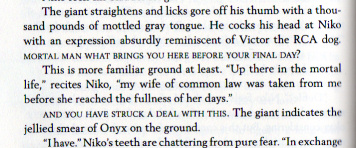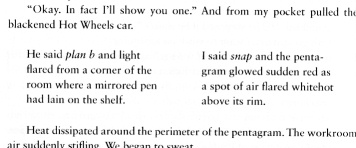
In the print version I called the chapter listing “Cantos” instead of “Table of Contents,” to emphasize the connection to Dante, cue the reader that the prose is often metered, announce something of my intent, and make the reader aware that there are 33 of them, as in Dante. Can’t call the ToC anything but “Table of Contents” in an e-reader.
None of these by themselves are that big a deal. And even in the aggregate they’re hardly cause for rending my garments and gnashing my teeth. So what am I bitching about?
I’m bitching because e-readers emphasize content. We use that word all the time. I need some content. It reinforces a view of a novel as information. And while a novel is information, the sequence of words isn’t the only way to convey it. The arrangement, look, feel, and placement of the words conveys information too. Having choices about layout and typography not only lets an author achieve an effect, it lets a publisher give a book its own identity. That’s why the job of Art Director exists.

Let me hasten to say that despite what the above may imply, I am extremely happy with the e-book of Mortality Bridge. I worked closely with the layout artist to find other ways to achieve what I wanted, and by and large I do’t believe that the compromises we had to make compromised the integrity of the book in any way. What it loses is some of the fingerprint I tried to bring to the experience of the novel. It’s hardly tragic. It’s not even bad. But it does point up the fact that, in my book, e-readers are not quite ready for prime time.
What e-readers offer that’s unique to digital media is highlighting, search, markup, full-on wiki-zation, internal and internet hyperlinking. This is one of the things that makes them superior to the printed book as a device. But the truth is that e-readers aren’t quite there with this yet, either. Most of this functionality exists to varying degrees with different e-readers (the iPad probably being the most fully loaded). But it’s still pretty clunky. And that’s a shame, because I would absolutely love to be able to present a digitized copy of Mortality Bridge not only laid out as the author intended, but available in an annotated, wiki-enabled edition, easily searchable, with internal links to similar lines, images, and references, and external links to other author’s works referenced, Google Earth maps, source art, you name it.

I have to say I was a bit surprised to learn all this. I admit that this surprise comes because I’ve read exactly one book on my Kindle: Mechanique: A Tale of the Circus Tresaulti, by Genevieve Valentine (whose name did not fit onto my contents list, and it took about 8 steps to get to it so I could write it correctly here). Mostly I use it as a tool for proofing my e-books. (I wasn’t given the opportunity to look at the e-book galleys of Elegy Beach, and now I wish I had, considering some of the typographic games I play in that book.)
I’m not landing on the wheezing geezer side of “Print book real book. E-book not real book.” I’m saying that, for what I want from a reading device, the e-book hasn’t yet surpassed the print book.
Still, I give it five years at the very most before everything I bitched about above is resolved and surpassed with flying colors. Then I’ll be happy to settle down with a cup of coffee and an e-reader.